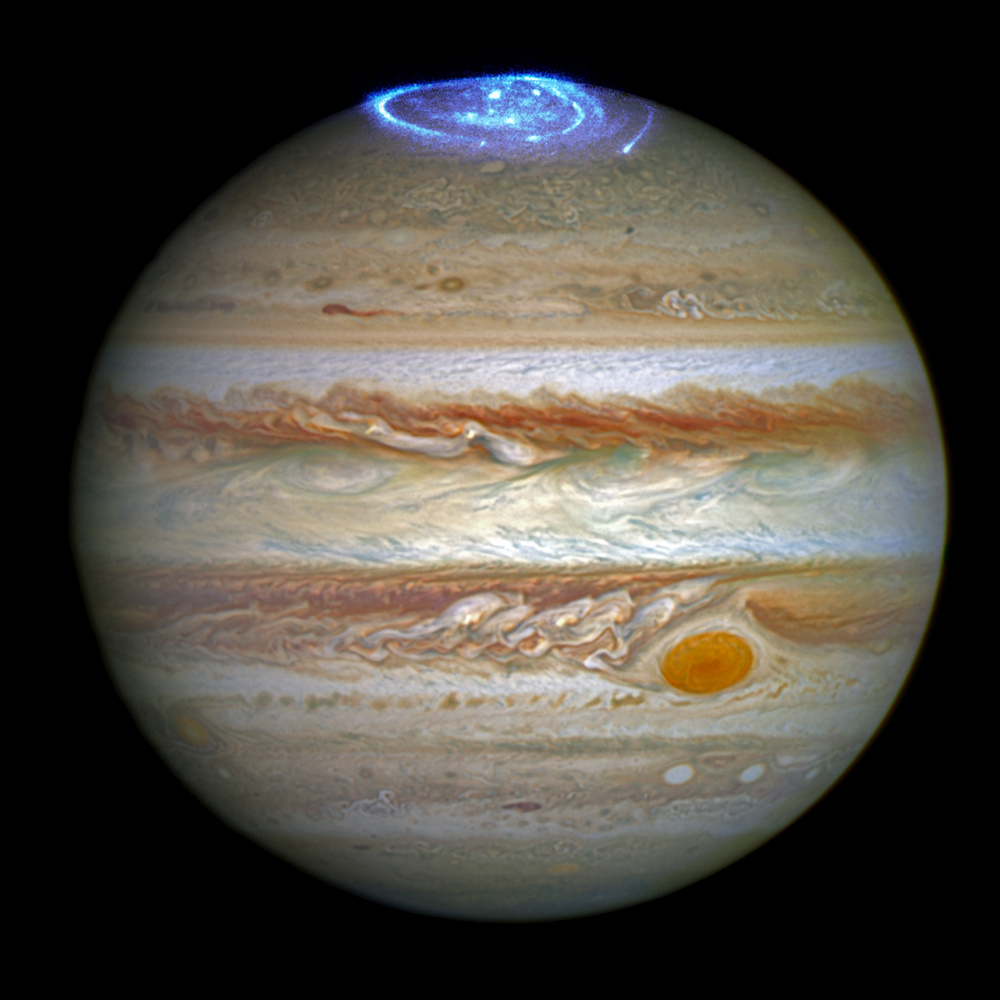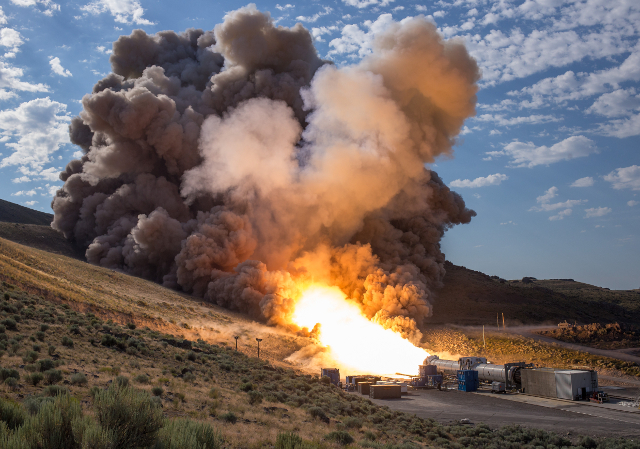Photo Credit: (NASA/Bill Ingalls)
***
Juno and Jupiter
The excitement is growing as Juno prepares for her 35 minutes of heart-stopping maneuvering tomorrow night. The first craft sent to Jupiter since Galileo is locked down and in autopilot until its insertion in complete late Monday night / early Tuesday morning. And as it approaches, all eyes are on Jupiter. A new set of images of Jupiter’s aurorae has been released as the Hubble Telescope continues to photograph the giant in the far-ultraviolet every day for the next few months, producing fantastic images like the one below which shows the aurora in blue set against a visible-light shot of the planet:

Another shot, this one in infrared, was captured this week as well by the VLT (Very Large Telescope), showing the roiling clouds beneath the planet’s “surface” (technically Jupiter doesn’t have a surface, but you know what I mean).

The timing isn’t accidental, of course. Both images were taken to help out the Juno mission, which if successful will give us some of the most detailed data on our solar system’s largest planet we’ve ever had. If you want to keep up with the orbital insertion on July 4, check out this timeline over at the Planetary Society. The NASA TV coverage should begin on the 4th at 10:30pm (EDT).

What’s Next For Dawn
As of Thursday, the Dawn spacecraft orbiting Ceres has completed its primary mission. It’s brought us not only tens of thousands of images of Ceres, but also of the asteroid Vesta, with a combined 69,000 images between them. It’s not only spotted the “white spots” on Ceres, but has given us at least two possible interpretations of them (and given us hope that there’s water on the closest dwarf planet to Earth). But the show isn’t over yet for Dawn. The limiting factor for the mission has always been its hydrazine fuel, but by working to conserve it, the team running the mission has found themselves with a surplus that could in theory take the mission into 2019 with a slow flyby of a third object in the asteroid belt. The good folks at NASA have until July 12 to decide whether to strike out in search of that as-yet undisclosed target, or else remain in Ceres orbit until it runs out of fuel next year. So a hearty congratulation to the Dawn team on an incredibly successful primary mission, and fingers crossed for that bonus. You can read more about the potential extension of the Dawn mission at Spaceflight Now.

SLS Solid Rocket Boosters
The Space Launch System, or SLS, is still progressing despite a somewhat outdated financing model (based largely on politics, it uses old tech from the space shuttle days to preserve or create jobs in key politicians’ districts). But it still seems to be on track, and we got more evidence of that this week when they tested a very, very powerful solid rocket booster in the hills of Utah. The one-use rocket produces about 3.2 million pounds of thrust — that’s a hell of a lot, and it’s not even the “full strength” version yet. When completed the SLS Block One design should have two of these suckers rated at 3.6 million pounds each, plus another (roughly) 1.7 million pounds of thrust from the center stage, for a total of 8.9 million pounds of thrust, or enough to get 70 metric tons to Low Earth Orbit. Just for comparison’s sake, SpaceX’s Falcon Heavy — which will basically be three Falcon 9’s strapped together — will have a total thrust of 5.1 million pounds of thrust, rated to carry just under 55 metric tons to LEO. Now, we can all argue about the reasonableness of this plan — the FH should in theory be reusable, and also much much much cheaper, but for carrying single, very heavy things to orbit the SLS will be one heck of a launcher. The Falcon Heavy will probably also be ready sooner: even if its first test flight slips from its December 2016 schedule, it’s hard to believe it’ll take until the SLS’s estimate of November 2018. For a really really detailed comparison of the FH and SLS, check out The Space Review.
Oh and you can watch a video of the test here.
ICYMI
In case you missed it, here’s what we got up to here this week:
- On Monday I hopefully introduced you to the awesomeness that is Vsauce
- On Tuesday I took a quick look at the post-ISS future
- On Wednesday I asked you to think twice before trying to make your pet a vegetarian (seek professional guidance!)
- On Thursday I talked about an open letter from Nobel Laureates to Greenpeace over GMOs, and
- On Friday, Elle celebrated the Supreme Court’s decision that Texas’s TRAP law HB2 was unconstitutional
If you missed any of those, go check them out now! (I’ll wait)
Best of the Rest
No man is an island, and no man has enough time to cover all the world’s news while still holding down a teaching gig, so here’s your weekly linkspam of things I didn’t get to!
- This year’s Formula E season draws to a close this weekend
- We found a new source of helium, so we can relax about that issue for a little while
- The number of Rhetts in the world is increasing exponentially
- A probably actually crazy person plotted to kill Stephen Hawking
- The frankly anti-science GMO labeling bill came into effect in Vermont, and
- Chuck Tingle had the best response to Brexit: parody erotica.
That’s all for today. Thanks for reading! I only get paid in my own (and your) enthusiasm, so please like This Week In Tomorrow on Facebook, follow me on Twitter @TWITomorrow, and tell your friends about the site!
If you like our posts and want to support our site, please share it with others, on Facebook, Twitter, Reddit — anywhere you think people might want to read what we’ve written. Thanks so much for reading, and have a great week.
***
Richard Ford Burley is a human, writer, and doctoral candidate at Boston College, as well as an editor at Ledger, the first academic journal devoted to Bitcoin and other cryptocurrencies. In his spare time he writes about science, skepticism, feminism, and futurism here at This Week In Tomorrow.
